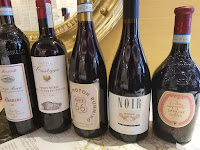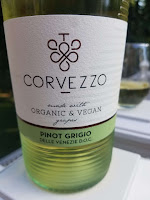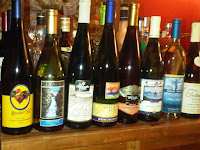 Lombardy is one of Italy's largest and most populous regions and is located in the north-central part of the country. It consists of five DOCG, 21 DOC, and 15 IGP titles with the Oltrepò Pavese DOC being one of the larger and better-known regions. Oltrepò Pavese refers to Pavia across the Po -- or more meaningful - the area south of the Po River. The region lies in southwest Lombardy and shares many common features with neighboring Piedmont as both regions were once ruled by the House of Savoy.
Lombardy is one of Italy's largest and most populous regions and is located in the north-central part of the country. It consists of five DOCG, 21 DOC, and 15 IGP titles with the Oltrepò Pavese DOC being one of the larger and better-known regions. Oltrepò Pavese refers to Pavia across the Po -- or more meaningful - the area south of the Po River. The region lies in southwest Lombardy and shares many common features with neighboring Piedmont as both regions were once ruled by the House of Savoy. Viticulture has been prevalent in Oltrepò Pavese for thousands of years as evidenced by the discovery of a fossilized caràsa, that is, a fossilized vine trunk, 25 cm long by 6 cm in diameter, found near Casteggio (Consorzio Tutela Vini Oltrepò Pavese). And why not. According to wine-searcher.com, "the vineyards of the Oltrepo zone sit among the foothills between the Apennines and the river Po in the provinces of Alessandria, Genoa, and Piacenza. The vines benefit from an excellent microclimate (thanks to its proximity to the Po), well-drained soils rich in clay and calcareous marl, and a terroir often compared to that of Barolo". In 1884 Oltrepò Pavese was home to at least 225 native vines, but today there are just a dozen that are the most widespread.
Viticulture has been prevalent in Oltrepò Pavese for thousands of years as evidenced by the discovery of a fossilized caràsa, that is, a fossilized vine trunk, 25 cm long by 6 cm in diameter, found near Casteggio (Consorzio Tutela Vini Oltrepò Pavese). And why not. According to wine-searcher.com, "the vineyards of the Oltrepo zone sit among the foothills between the Apennines and the river Po in the provinces of Alessandria, Genoa, and Piacenza. The vines benefit from an excellent microclimate (thanks to its proximity to the Po), well-drained soils rich in clay and calcareous marl, and a terroir often compared to that of Barolo". In 1884 Oltrepò Pavese was home to at least 225 native vines, but today there are just a dozen that are the most widespread. Last week I attended a fascinating lunch at Cafe Milano featuring wines from Oltrepò Pavese presented by Carlo Veronese, the director of the Consorzio Vini Oltrepò. Even though there are 20 classifications within Oltrepò Pavese, this tasting focused on the Oltrepò Pavese Metodo Classico DOCG, Oltrepò Pavese Pinot Grigio, Pinot Nero dell'Oltrepo Pavese, and Sangue di Giuda dell'Oltrepo Pavese. And notice that the wines of Oltrepò Pavese are generally named from the vines from which they are made and not just the region.
Last week I attended a fascinating lunch at Cafe Milano featuring wines from Oltrepò Pavese presented by Carlo Veronese, the director of the Consorzio Vini Oltrepò. Even though there are 20 classifications within Oltrepò Pavese, this tasting focused on the Oltrepò Pavese Metodo Classico DOCG, Oltrepò Pavese Pinot Grigio, Pinot Nero dell'Oltrepo Pavese, and Sangue di Giuda dell'Oltrepo Pavese. And notice that the wines of Oltrepò Pavese are generally named from the vines from which they are made and not just the region. Pinot Nero dell'Oltrepò Pavese DOC
Pinot Nero dell'Oltrepò Pavese DOCOltrepò Pavese is considered the Pinot Nero (Noir) capital of Italy as more Pinot Nero is planted there than anywhere else in Italy. Interestingly, the original genotypes of Pinot Noir were already cultivated in the Oltrepò areas by the ancient Romans and may have been the source of Pinot Noir in the south of France. However, the current Pinot Noir vines derive from French selections that were planted after the Phylloxera epidemic. Pinot Nero can be labeled as a vintage wine or a Reserva with a minimum of two years of aging.
The Cantina di Casteggio Pinot Nero Dell'Oltrepò Pavese DOC 2020 is a lighter style but with noticeable tannins and a little chewy mint.
The Dino Torti Pinot Nero Dell'Oltrepò Pavese DOC 2019 was perhaps my favorite despite the interesting branding. It's floral with creamy red raspberries and cherries and a viscosity throughout.
The Mazzolino Pinot Nero Dell'Oltrepò Pavese DOC 2018 was the biggest of the reds, aged twelve months in oak and offering a tea and pepper aroma, a full-bodied interior, with a firm and lasting finish.
Oltrepò Pavese Metodo Classico DOCG Metodo classico is Italy's version of Champagne's methode classique and Pinot Nero is dominant in all wines made under this title. The sparkling wine can be made either as a white or rosé and 70 percent or more of the final blend must be Pinot Nero. This percentage increases to 85 percent for wines claiming the varietal title Oltrepò Pavese Metodo Classico Pinot Nero. Picked at the early stages of skin ripeness, Pinot Nero displays a good balance of acidity and sugar required for these sparkling wines.
Metodo classico is Italy's version of Champagne's methode classique and Pinot Nero is dominant in all wines made under this title. The sparkling wine can be made either as a white or rosé and 70 percent or more of the final blend must be Pinot Nero. This percentage increases to 85 percent for wines claiming the varietal title Oltrepò Pavese Metodo Classico Pinot Nero. Picked at the early stages of skin ripeness, Pinot Nero displays a good balance of acidity and sugar required for these sparkling wines.The Asburgico Oltrepò Pavese DOCG Metodo Classico Pinot Nero 2018 explodes in the mouth with textured citrus notes.
The Azienda Agricola Quaquarini Francesco Oltrepò Pavese DOCG Metodo Classico Pinot Nero 2014 needed a few minutes to open then the floral, white grapefruit and a little tropic fruit notes rushed out.

Oltrepò Pavese Pinot Grigio DOC
This title applies to still and frizzante white wines containing at least 85 percent Pinot Grigio.
The Vanzini Oltrepò Pavese Pinot Grigio DOC was an eye-opener on the region's richer style and orangish-colored versions of this varietal wine.
Sangue di Giuda dell'Oltrepo Pavese DOC
The title translates to "Blood of Judas" and applies to sweet red wines which can be still, frizzante (semi-sparkling), or spumante. Barbera and Croatina must each account for between 25 and 65 percent of any blend with Pinot Nero, Uva Rara, and Vespolina alone or in any combination, accounting for 45 percent. The intriguing and sometimes controversial name Sangue di Giuda means "Blood of Judah" or "Blood of Judas".
The Losito & Guarini Sangue Di Giuda Dell'Oltrepò Pavese DOC, C'era Una Volta 2021 is a low alcohol (6%), full-bodied, and fresh wine where the sweetness is partially obscured by the abundant acidity.
Oltrepò Pavese Riesling
The Ca Di Frara Oliva Oltrepò Pavese Riesling DOC also provides a darker copper color with tropical and petrol notes.
Oltrepò Pavese Barbera
The Ca Montebello Oltrepò Pavese Barbera DOC 2020 is fruit-forward, and very friendly with a floral start and a slight mocha tail.













































